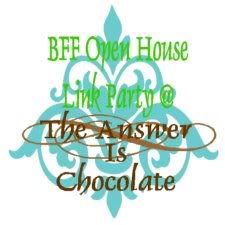The knock off I am sharing today is a woodworking project. I don't actually make many knock off projects. Here's what always happens to me... I see something at a store or in a catalog and think "I could make that", but then I never follow through or I figure out it would have been cheaper to just buy it. My knock off today, however, is a different story. I had the motivation (Jess asked me to guest post :) and I managed to knock off a $259 item for about $75. Ready to see it?
Here is the Ballard Designs Pruvost Wall Plaque...
 |
| image source |
Not bad, huh? I have been looking for something to fill this large, kind of strange wall space up near the vaulted ceiling in our dining room, and this fits the bill perfectly. The Ballard version is 23" high by 80" wide. My version is 22" high by 72" wide. And you probably noticed that the Ballard version is written in French. The French doesn't really fit in with the decor in our home, so I went with something a little more my style.
I was looking for something large to fill the space and make a bold statement. I love how it looks up there. Want one of these for your home? Here's the how-to...
Materials and supplies:
- Three 1x6" pine boards, 6ft long each
- 1x2" pine board, 6ft long
- 3ft piece of molding
- paint for molding (I used a Martha Stewart pre-tinted tester in Bay Leaf from Home Depot)
- stain (I used Minwax Wood Finish in Dark Walnut)
- wood glue (I used Gorilla brand)
- 16 wood screws, 1 1/4" long
- 1/4" doweling kit (optional)
- foam brushes for painting and staining
- stencil cream (I used Delta Blendable Stencil Paint Creme... highly recommended)
- round foam stencil brush
- letter stencils (mine were 3.75" tall)
- extra large piece of paper
- pencil
- scissors
- sandpaper
- screwdriver
- clamps
- drill
- jigsaw
- circular saw
- painter's tape to hold your stencil in place
Instructions:
*Disclaimer: I am NOT an expert. There are probably much better ways to do some of the things that I did on this project, but this is what worked for me. There is risk involved when using power tools. Please use caution and safety equipment (like safety glasses) when using power tools. If you are not comfortable using power tools, enlist the help of someone who is.
Step 1: Cut one of your 1x6" pine boards into two 27" long pieces.
Step 2: Line up your boards for the sign. Place the two 6 foot long 1x6" boards side by side at the bottom. Place the two 27" long 1x6" pine boards from Step 1 side by side at the top. From this point on I will refer to the boards by the letter labels shown in the photo below.
Place the right edges of boards C and D 22.5" from the right edges of boards A and B.
Step 3: Now you need to decide how you want the cut out design of your plaque to look. I took a pencil and drew right on the boards. This took me a while, and I erased and redrew several times until I was happy with how it looked. You only have to do this on one end of your plaque. I drew my design on the right end. Feel free to trace cups or other rounded edges and use a straightedge to get the lines you want.
This is how my penciled in design looked when I was done...
Step 4: Now it's time to get out the jigsaw and cut. Very carefully cut along the lines you drew on each board. I cut each board separately.
Step 5: Sand the edges of each of your cuts.
If you line up all of your boards, this is how it should look at this point (aside from differences in your cut design)...
Step 6: Now it's time to transfer your design to the other end of the plaque. Take a large piece of paper and lay it under the end that you just cut. I used a piece of packing paper that's been sitting in my basement since we moved into our house two years go. It was pretty wrinkly, but it did the job.
Use a pen or pencil to trace around the entire end of your sign.
Use scissors to cut your paper along the line you just traced. Flip your paper over so that the design is a mirror image of the first end you cut.
 |
| Ping-pong anyone? |
 |
| You have to look closely, but there is a pencil tracing of the paper template on there. |
Step 8: Now it's time to cut your molding. First you need to determine the angle at which you want to place your molding. I eyeballed it with the first piece. I started with the molding overhanging the left edge of board D by about a 1/2".
I made a mark at the center of the top edge of board D and made sure the bottom edge of my molding hit this mark, then drew a line straight up across my molding (at a 90 degree angle to board D) to give me the angle at which I needed to cut my molding.
Use a saw to cut your molding along the line you just drew. Now, lay your newly cut piece of molding back-to-back against the remaining piece of your molding. Trace the angle and length of your cut piece onto the remaining piece. Cut the remaining piece along the two lines you just drew. Sand the cut edges of both pieces of molding. This is how your molding should look when you are done...
Step 9: Notice those little corners sticking up behind the molding at the top left and right corners of board D in the previous photo? Once you have the molding laid out how you want it, trace the top edge of both pieces of molding onto board D. Use your jigsaw to cut along those lines on board D. Now those little corners won't stick up.
Step 10: Assembly time! My husband suggested using dowels between the boards so that the boards don't warp or bend over time. It's optional, but I thought it was a good idea. We bought this 1/4" doweling kit, and it had everything we needed to properly drill the holes for the dowels and make sure that our dowels lined up with the holes between each set of boards. The instructions are right on the kit, so I won't go into detail here, but it was well worth the $5.47 we paid for it...
We used four dowels between boards A and B and three each between boards B and C and boards C and D.
Now for the wood glue. I used Gorilla brand wood glue, which I have used on previous projects/repairs, and I find that it holds really well.
Run a bead of glue between each set of boards (and in the dowel holes, if you used them).
Clamp your boards together. Use a damp cloth to wipe away any glue that runs out the front of the plaque. The glue won't take the stain, so make sure you get it all off. Let it set for about 24 hours.
Step 11: While you are waiting for your wood glue to dry, you can paint your molding. I used a foam brush.
Step 12: Now that your wood glue is dry, you need to add some bracing to the back of your plaque. Cut your 1x2" board into four pieces: two pieces that are 19" long and two pieces that are 8" long. Flip your plaque over so that the back is facing up. Place the 1x2" boards in the following locations (You don't need exact measurements. Just space them out across the back of the plaque)...
Pre-drill your holes, then attach the 1x2" pieces onto the back of the plaque using wood screws.
Step 13: Time to stain. I used Minwax Wood Finish in Dark Walnut. It came out a little darker than I expected, but I don't think I would change it. I was worried about the stenciling showing up against the dark stain, but it turned out just fine.
Step 14: If you want to give your molding an aged look, brushed on some of the stain, especially in all the nooks and crannies, then wiped it off with a soft cloth. Attach the molding to the top of the plaque using wood glue.
Step 15: This is probably the most nerve-racking part of all... the stenciling. This was my first real stenciling experience, and I have to say that I was completely shocked at how easy it was. I think it had everything to do with the stencil paint that I bought. I used Delta Blendable Stencil Paint Creme, and it was a dream to work with. I have zero affiliation with Delta, but I'd pay them to let me talk about how awesome this stuff is. It's very thick, and it doesn't smudge AT ALL. Even when you place the stencil for the next letter on top of it. It doesn't seep under the edges of the stencil, either. Perfect letters every time. I just used a round foam stenciling brush, and it worked really well. Love this product. I took a few measurements to decide where I wanted my words and got to work. Painter's tape works great to hold your stencil in place.
Once you have all of your wording stenciled on, you're done! And you paid just under 30% of what it would have cost you to buy it. And that doesn't include shipping! Want to save even more money? I sprung for the premium pine because I didn't want a lot of knots in my wood, but if you like the look of knotty pine, you can save yourself a few more dollars. Isn't it a beauty?
I should probably tell you that my father-in-law owns a feed store named S.E. Smith, which is how I came up with all of the wording. I also want to give a special thank you to my husband for helping me out with this project (and for being a hand model in some of the photos :). I couldn't have done it without him.
This project was a lot of fun! Don't be intimidated by it. It was actually pretty simple and went much quicker than I expected it to. Feel free to contact me if you have any questions. And if you're into knock offs, check out my Land of Nod wall art knock off, too. Thanks for stopping by today!

Linking up at:
 |  |































17 comments:
This is amazing Gwen! It looks every bit as "Ballardy" as the Ballard sign and for a fraction of the cost I'm sure. Great job!
I still love it! The colors are gorgeous. I need to get working with some wood- it's been too long! :)
xoxo,
Amy
Stellar project and PERFECT for the place you made it for! Thanks for the wonderful tutorial!
OOH OOH! I saw this in Ballard a few times and LOVED it! You came up with the PERFECT rendition of it!!! :)
www.iheartmygluegun.com
Wow Gwen! This is gorgeous! I would never be able to tell the difference:)
Woweeeee! This is absolutely fantastic! I've never seen you do a woodworking project before but you've knocked my socks off. It's AWESOME!!
Sarahx
Hi Gwen!
I'm visiting from Roeshel's. The post grabbed my attention. I really love your Ballard's knock-off sign. It's different from a lot of signs floating out there. The tute was very helpful. I'm going to look for some of the stenciling paint you used. Getting ready to make my first sign. Nothing this grand, yet.
Looks great! :)
So glad you linked this up! It's so fantastic!
Why didn't I see this before I spent 299.00 at Ballard. :( sniff, sniff. Imagine having all that extra money to spend on more copy cat things I want and can't afford. ack!!!
Ohhhhh..
you are a genius!
I love it! What a neat shape, and a great home for this treasure.
I saw this in their catalog and really liked it. You did an awesome job. I would never have thought of making it on my own but you make it look entirely possible for a novice like me. Very nice!
You did a great job, Gwen. Your instructions were done well, too. It looks like you spent big bucks on it. :)
Hi Gwen! You did an amazing job! Your tutorial is Awesome!!
Hi Gwen... just wanted to let you know that I linked back to you on one of my posts. Hope you don't mind.
Love your version of this board.
Your tutorial is perfect. Great job. Thanks so much for sharing it.
Found you over at Knock-Off Decor.
Hugs, Deb
I just saw this tutorial. I was at my lows ready to pick up the materials but chickened out. I could bout find any boards that would line up flat. Which got me to thinking why you had not used wider pieces. Was it because it's easier to cut or warping concerns ? I just coul not figure how I was going to line up the boards so that the dowels would fit.
mylien - I used the four boards because that's how the original Ballard plaque was done and because really wide planks are usually expensive and more difficult to handle when cutting. If you buy one of the doweling kits that I mention in Step 10, it marks where the dowel will go on both boards at the same time so they will line up. Hope this helps :)
Post a Comment
Note: Only a member of this blog may post a comment.